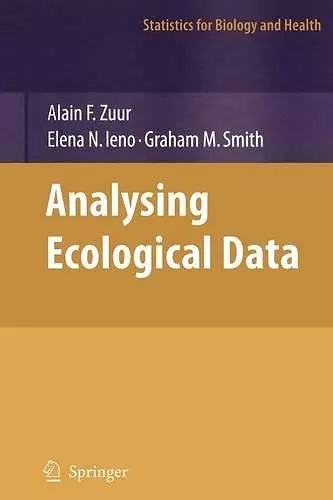Analyzing Ecological Data
Graham M Smith author Alain Zuur author Elena N Ieno author
Format:Paperback
Publisher:Springer-Verlag New York Inc.
Published:11th Feb '11
Should be back in stock very soon
This paperback is available in another edition too:
- Hardback£245.50(9780387459677)

'Which test should I apply?' During the many years of working with ecologists, biologists and other environmental scientists, this is probably the question that the authors of this book hear the most often. The answer is always the same and along the lines of 'What are your underlying questions?', 'What do you want to show?'. The answers to these questions provide the starting point for a detailed discussion on the ecological background and purpose of the study. This then gives the basis for deciding on the most appropriate analytical approach. Therefore, a better start ing point for an ecologist is to avoid the phrase 'test' and think in terms of 'analy sis'. A test refers to something simple and unified that gives a clear answer in the form of a p-value: something rarely appropriate for ecological data. In practice, one has to apply a data exploration, check assumptions, validate the models, per haps apply a series of methods, and most importantly, interpret the results in terms of the underlying ecology and the ecological questions being investigated. Ecology is a quantitative science trying to answer difficult questions about the complex world we live in. Most ecologists are aware of these complexities, but few are fully equipped with the statistical sophistication and understanding to deal with them.
From the reviews:
"I liked the compact style of the book and really enjoyed the case studies. The book would be a suitable companion to statistics courses for both ecologists and statisticians at the introductory graduate level….All in all, I enjoyed reading the book and marvel at the wide range of sophisticated statistical models used in modern ecology."(Biometrics, 64, March 2008)
"Readership: Undergraduates, postgraduates and scientists engaged in areas of the environmental sciences and ecological research. The material presented in this book has been developed and used by the authors in teaching statistics to its intended readership. The text is divided into two parts … . I have no doubt that for undergraduate students the main strength of the book will be the breadth of topics covered by the case studies – ranging from terrestrial ecology to marine biology." (C. M. O’Brien, International Statistical Review, Vol. 75 (3), 2007)
"This is a practical way of analysing ecological data in which methodological approaches are combined with real data sets with the advantages and disadvantages of each strategy discussed. Who is it for? Upper undergraduates, postgraduates and researchers in ecology. Presentation It links ecological data, data analysis and discussion of the approaches. Would you recommend it? If you want an edited volume on different methods of ecological data analysis, then this book is worth looking through." (Times Higher Education, May, 2008)
"The book is aimed at three types of readers: ecologists who wish to develop their own statistical skills, quantitative ecologists who want to use more advanced techniques, and statistical scientists seeking more experience analyzing ecological data. … Enjoyable aspects of the book include good graphical outputs, with interpretations, in the text. … Overall, this book is wroth the purchase price … . No other book combines as many good ecological data sets with suchthoughtfully written analyses. I give this book two enthusiastic thumbs up!" (Loveday Conquest, Journal of the American Statistical Asociation, Vol. 103 (483), September, 2008)
"The book aims to give readers sufficient information to apply statistical methodology in a correct and useful way. … the book meets its aim, covering a wide range of statistical techniques and dealing with many situations that are encountered in ecological statistics. This is an excellent, nicely presented and very readable book. I would highly recommend it to numerate researchers and students interested in environment and ecological data analysis." (Weiqi Luo, Journal of Applied Statistics, Vol. 36 (2), February, 2009)
"Analysing Ecological Data by a group of ecologists-gone-statisticians from Scotland is the latest book in this area and based on years of teaching and consultancy experience. … The book differs from many of its competitors in its structure: it contains a general introduction to several fields of descriptive ecological data analysis (370 pages), which is augmented with 17 chapter-length case studies … . In summary, I can recommend the book primarily as advanced material for ecologists … ." (Carsten F. Dormann, Basic and Applied Ecology, Vol. (10), 2009)
ISBN: 9781441923578
Dimensions: unknown
Weight: unknown
672 pages
Softcover reprint of hardcover 1st ed. 2007